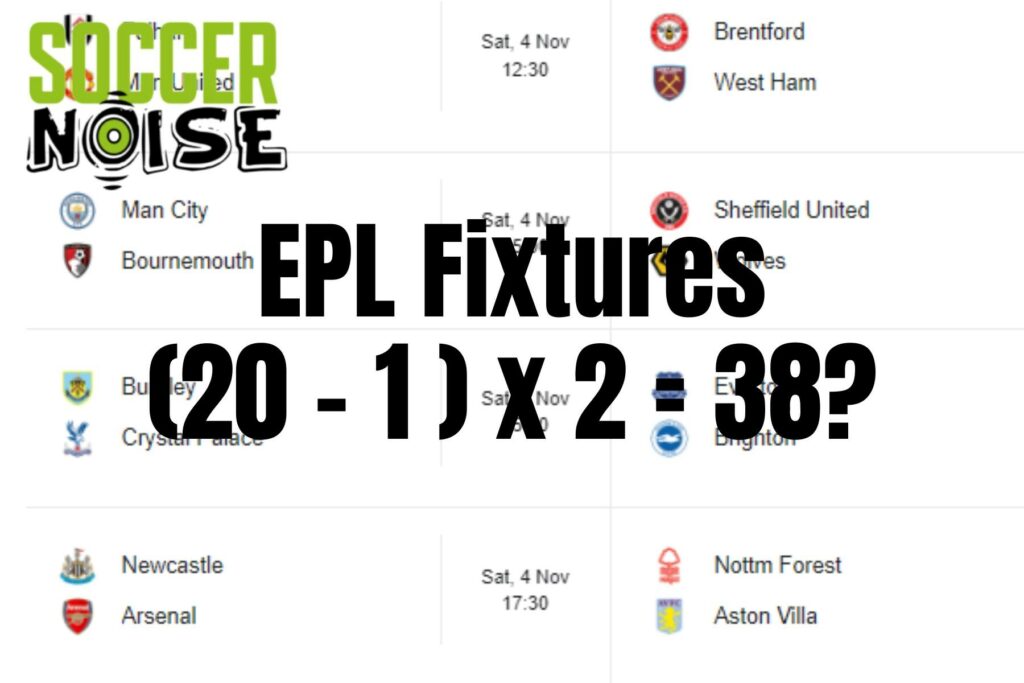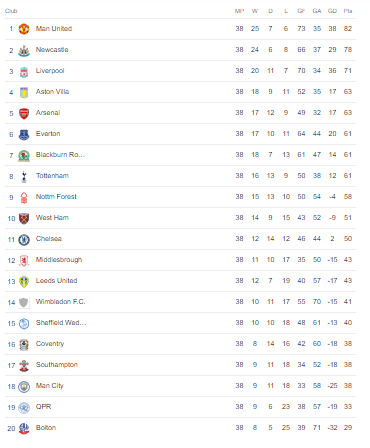The 38 game Premier League season is iconic. Supporters of Premier League clubs know that come game 38 the season will be over, win, lose or relegated. What comes next can be the greatest moment in a fans life or the agony of facing a trip back down to the championship.
Why is the premier league 38 games? The Premier League is 38 games, because there are 20 teams in the League. Each team plays each of the other 19 teams both home and away. 19 (opponents) multiplied by 2 (home and away) is 38. Prior to the 1995-96 season the Premier League featured 22 teams, and so each team played 42 games. In total, the Premier League currently features 380 fixtures. Each team plays 19 home games. 19 (home games) multiplied by 20 (teams) is 380 fixtures.

Below we dive into how the 38 game Premier League season works and if this is the same across the other major European football leagues.
How many games were in the Premier Leagues first season?
When the old English Division 1 became the Premier League for the 1992-93 season it featured 22 teams. Each of these teams played 21 games at home and 21 games away, totalling 42 games each. This meant that the Premier League itself saw 462 fixtures played.
In terms of the structure, it was similar to today, with 3 points for a win, 1 for a draw and 0 for a loss. The champion was crowned after the final league fixture, there were no playoffs and the bottom 3 teams were relegated. To be replaced by the winner, runner up and playoff winner from “Division 1” now known as the Championship.
This was all just as it was in the old Division 1 the season before. The only significant change to the competition was the rebranding of the name, although behind the scenes it was a completely different world.
When did the Premier League switch to 38 games?
The first three Premier League seasons featured 22 teams. 1992-3 & 1993-4 all saw the title contested by 22 teams with the bottom 3 relegated to be replaced by 3 clubs from the division below.
This format changed in 1994-95, while 22 teams would start the Premier League season a temporary change to the rules would see 4 teams relegated to be replaced with just 2 from the division below. This would permanently reduce the Premier League to 20 teams. The following season the League would be contested by 20 teams, playing 38 games each, a total of 380 fixtures. This was a significant chunk, 82 fixtures less than in previous seasons.
The 4 relegated teams were, Ipswich Town, Leicester City, Norwich City and Crystal Palace. Palace were the unlucky ‘extra’ 4th team to be relegated. They wouldn’t return to the Premier League again for 2 seasons, winning the 1997 Division 1 Playoffs to gain promotion.
The sides that were promoted to fill out the 20 team Premier League for the start of the first 38 game season in 1995-96 were; Middlesbrough and Bolton Wanderers. Middlesbrough came up as Champions, while Bolton gained the second and final promotion spot by winning the Playoffs.
1995-96 would see the first 20 team Premier League, where each team played 38 games in total.

1995-96 Premier League Table
Why is The Premier League 20 teams?
Despite its origins as a 22 team league, there was always the intention to reduce the number of clubs in the Premier League to 20. The goal was to promote development and excellence at club and international level, given the success of the Premier League over the last 3 decades it’s hard to argue against the idea. The reduction was achieved at the end of the 1994-95 season when four clubs were relegated and just two promoted.
The reduction in teams and therefore fixtures, more closely aligned the English top flight with those of the other big leagues in Europe. There were already concerns over fixture congestion given that the English Football season features 2 domestic cups, instead of the just 1, which is more common in other major European Leagues.
During the 1995-96 season when the Premier League first played a 20 team 38 games fixture calendar the other 4 major European Leagues had the following setups;
1995-96 Major European Leagues
- Italy, Serie A – 18 Teams, 34 games
- Germany, Bundesliga – 18 Teams, 34 games
- France, Ligue 1 – 20 Teams, 38 games
- Spain, La Liga – 22 Teams, 42 games
Italy now has 20 teams, 38 games. It was increased after the 2003-04 season.
Germany still has 18 teams, 34 games. It hasn’t changed since 1965.
France now have 18 teams, 34 games, reducing for the 2023-24 season.
Spain now has 20 teams, 38 games after reducing ahead of the 1997-98 season.
Does English football have too many games?
Given the 20 team top league (joint highest in Europe) and the two domestic cups, coupled with the lack of a winter break there is certainly an argument to be made that the English game has too many fixtures each season. A reduction could suit everyone, except the fans who love football, the broadcasters who would lose revenue, the owners who would lose profit and the players who would have to take a wage cut.
Given the amount of money in the English game it is not unreasonable to expect the Premier League teams to be able to compete on all fronts, using the League Cup as a testing ground for young players and new ideas. Building a well balanced squad large enough to compete on 4 fronts each season should be a minimum requirement for a Premier League Club ambitious to compete in Europe.
Instead of reducing the amount of games, clubs, managers and players should accept the fact that they cannot field their best 11 each game. Using a squad has never been a more valuable skill for a football manager than in the Premier League in 2023.
How are Premier League fixtures decided?
Premier League fixtures are worked out using a fixture computer that will randomly assign the fixtures based on pre set criteria. Unlike US sports, they are not hand picked to put the best matchups on the most valuable days.
